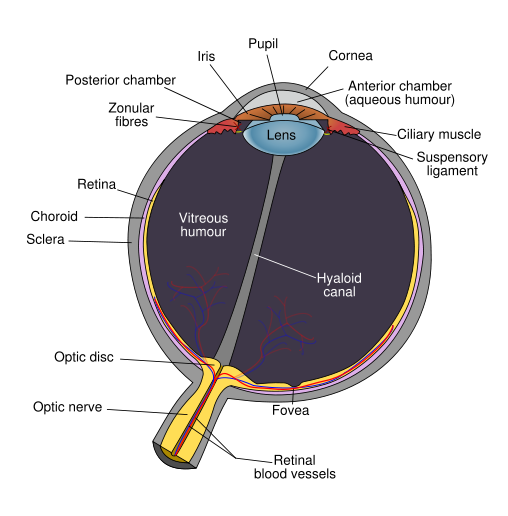Vitreous humour
Editor-In-Chief: C. Michael Gibson, M.S., M.D. [1]
Overview

The vitreous humour (British spelling) or vitreous humor (U.S. spelling) is the clear gel that fills the space between the lens and the retina of the eyeball of humans and other vertebrates. It is often referred to as the vitreous body or simply "the vitreous".
Composition
The vitreous is 99% water, but has a viscosity two to four times that of pure water, giving it a gelatinous consistency. Other components include salts, sugars, phagocytes, and a network of collagen fibres. Thus, unlike water, it has a refractive index of 1.336[1]. The phagocytic cells in the vitreous serve to remove unwanted debris in the visual field.
Hyaluronic acid was first isolated from vitreous humour.
Function
The primary purpose of the vitreous humour is to provide structural support to the eyeball while offering a clear unobstructed path for light to reach the retina.
The vitreous is also believed to function as a barrier to the forward diffusion of oxygen from the retinal blood supply to the anterior segment of the eye, where it can cause oxidation damage to the lens. Since the vitreous does not regenerate after being removed from the eye (a procedure known as vitrectomy, which is usually performed to allow surgical access to the posterior segment of the eye), early cataract is a frequent complication of retinal surgery.
Pathology
The collagen fibres of the vitreous are held apart by electrical charges. With aging, these charges tend to reduce, and the fibres may clump together. Similarly, the gel may liquefy, a condition known as syneresis, leading to cells and other organic clusters to float freely within the vitreous humour. These commonly lead to floaters which are perceived in the visual field as spots or fibrous strands. Floaters are generally harmless, but the sudden onset of recurring floaters may signify a posterior vitreous detachment (PVD) or other diseases of the eye.
Clinical significance
The metabolic exchange and equilibration between systemic circulation and vitreous humour is so slow that vitreous humour is sometimes the fluid of choice for postmortem analysis of glucose levels or substances which would be more rapidly diffused, degraded, excreted, or metabolised from the general circulation.
External links
References
de:Glaskörper eu:Humore beirakara it:Corpo vitreo lt:Stiklakūnis nl:Glasachtig lichaam no:Glasslegeme fi:Lasiainen sv:Glaskropp